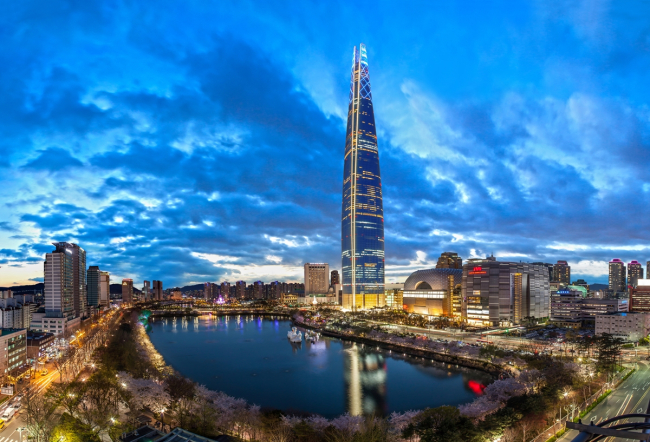[Weekender] How do skyscrapers work?
Evolving technology behind safer, more efficient, taller buildings
By Cho Chung-unPublished : Dec. 15, 2017 - 16:47
Skyscrapers are not just buildings that are tall, but are the outcome of a complex combination of evolving technologies. From highly sophisticated engineering techniques to futuristic elements, today’s skyscrapers have absorbed the latest technology to realize a luxurious human dream.
The challenge when building a skyscraper is how to overcome the forces of nature -- wind, heat from above and below and natural disasters that can happen without warning.
The key to overcoming these challenges is in the foundations, engineers say.
The taller the building, the stronger the foundation has to be.

Lotte World Tower, the world’s fifth-tallest building and located in Seoul, weighs 750,000 metric tons, equivalent to the weight of 10 million people. To buttress the tremendous weight, engineers dug 38 meters below ground to create its foundations, according to Lotte Property and Development. The building sits atop a 6.5-meter-thick concrete slab, which is held up by 108 concrete piles that are 30 meters long and 1 meter in diameter.
“The company used special concrete to resist fire for at least three hours so that it could delay the melting of the steel structure inside,” the company said. “The concrete foundation and technology we used is enough to buttress a 1-kilometer or taller building,” it added.
The concrete core also works with a steel diagrid shell unitized curtain wall.
A diagrid uses triangular structures to hold the weight of the building and increase horizontal resistance to typhoons and earthquakes.
Lotte World Tower can withstand 80-meter-per-second winds or an earthquake up to magnitude 9.
Each diagrid is covered with curved, heat-reflected glass that naturally changes the color of the building from day to night and due to seasonal changes. The Low-e glass increases energy efficiency, blocking outside heat entering the building in the summer and keeping heat inside in the winter.
The most fascinating feature of the high-rise building is perhaps the elevator.
Lotte World Tower has 61 elevators, including 17 double-deck elevators that lift passengers to offices and the observatory tower. The tower is the first in Korea to use double-deck elevators to increase energy efficiency and capacity. The elevator traveling to the top of the building can lift 54 passengers at once, and reaches the observatory in one minute, moving at 10 kilometers per hour. Lotte World Tower is a 555-meter skyscraper with 123 stories.
The elevator has adopted the latest security system that lets passengers know which elevator to take once passing the security gate at the lobby.
Do not use the elevator in case of fire is what children are being taught in school. But in supertall buildings like Lotte World Tower, elevators are additionally designed as lifesaving vessels.
In case of fire, 19 elevators of the 61 switch to emergency mode, said Seo Kyu-ha, a publicist for Lotte Property and Development. “They are resistant to smoke and flames, and have three layers to protect the electricity system that works independently even if the power cuts off because of fire,” he added.
In the future, elevators are expected to operate without cables. Elevator companies are seeking ways to develop cable-free cars that use electromagnetic levitation that can enable them to move in any direction.
By Cho Chung-un (christory@heraldcorp.com)



















![[Today’s K-pop] BTS pop-up event to come to Seoul](http://res.heraldm.com/phpwas/restmb_idxmake.php?idx=642&simg=/content/image/2024/04/17/20240417050734_0.jpg&u=)